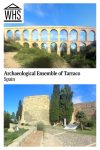Archaeological Ensemble of Tarraco
By Elliott Farmer
What is the Archaeological Ensemble of Tarraco?
Tarraco (modern-day Tarragona) was the first Roman settlement in Spain. It grew to become a major provincial mercantile port city and the Roman administrative capital of the Iberian Peninsula (Hispania Citerior). To put this into perspective, the Roman Empire ruled all of what is today Portugal and Spain from the city of Tarraco, which is why Tarragona has the largest collection of Roman ruins in Catalonia.
Disclosure: This article contains affiliate links. Making a purchase through an affiliate link will mean a small commission for this website. This will not affect your price. Privacy policy.
The Tarraco Roman ruins are generally in a very good state of preservation with some substantial structures still standing. As you walk around the city you get glimpses of Roman remains as well as the principal fee-charging monuments listed below.
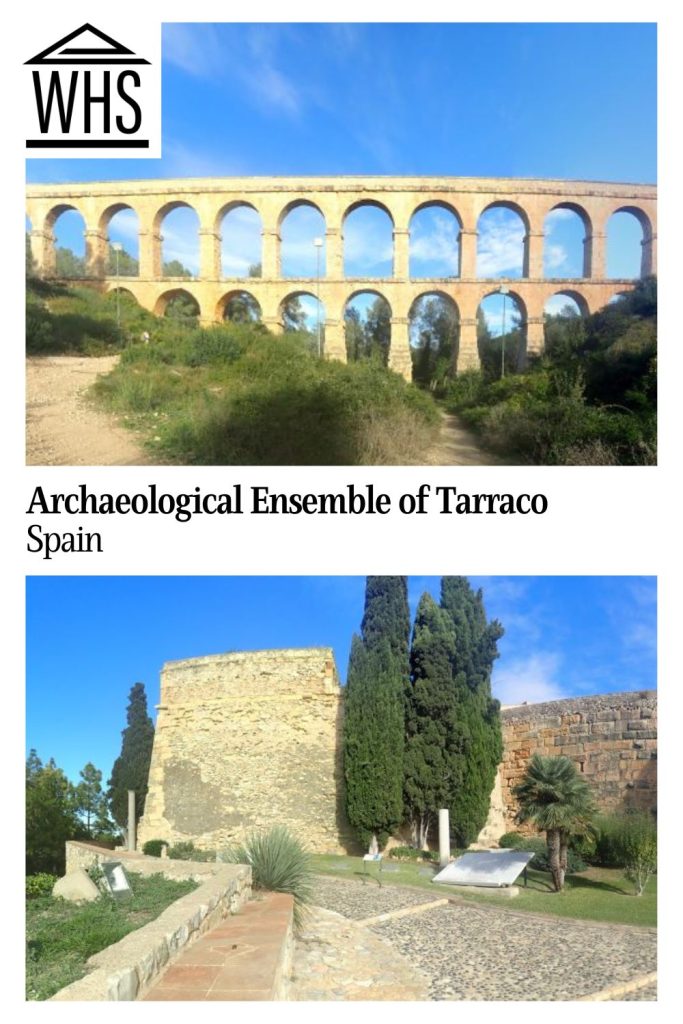
The diverse Roman monuments and buildings in and around Tarragona served a variety of functions – entertainment, administrative and governmental, religious and everyday life – which makes Tarragona a good visit to experience all aspects of Roman civilisation.
The Ensemble consists of 14 monuments spread out across modern-day Tarragona city and the surrounding countryside along the coast.
I have grouped the monuments into three categories based on location.
Part Alt (The high part)
Part Alt was the administrative capital of the Roman Empire in Iberia. What is today the old medieval town of Tarragona is built on top of the Roman administrative capital. It is here that you will find the highest concentration of ruins. Part Alt is so named because it sits on top of a 160-metre-high plateau (525 feet). It contains the following monuments:
- The Amphitheatre, Basilica and Romanesque church
- The Circus
- Provincial Forum
- The Imperial Cult Enclosure
- Roman walls
Lower part and Port Serallo area
This is the residential part, where the workers and ordinary citizens of the Roman city lived. It continues to serve this function today. Here you will find a scattering of Roman ruins amongst a modern cityscape:
- The Roman Theatre
- The Colonial Forum
- The Paleo-Christian Cemetery
Outside of Tarragona city
Outside of Tarragona city are several prominent Roman ruins. These locations are great to visit as part of a beach day or coastal walking trip because they are near to or on the Costa Dorada and reachable via train.
- Aqueduct of Les Ferreres
- Tower of Scipios
- Médol Quarry
- The Centcelles Villa-mausoleum
- The Villa dels Munts
- Triumphal Arch of Berá
All the sites are marked on the Google map below:
Why is the Archaeological Ensemble of Tarraco a World Heritage site?
This collection of ruins was awarded World Heritage status in 2000. While the remains are quite fragmented, according to UNESCO, “they present a vivid picture of the grandeur of this Roman provincial capital.” Tarraco was important in the history of Roman urban planning, and it served as a model for other Roman cities. At the same time, it provides “eloquent and unparalleled testimony to a significant stage in the history of the Mediterranean lands in antiquity.”
What can you expect on a visit to the Archaeological Ensemble of Tarraco?
Part Alt
The Amphitheatre
The second-century Amphitheatre was used as a live venue for events such as public executions, gladiatorial fights, beast fights and live hunts. The Christian Bishop Fructos and his two deacons were burnt alive in this amphitheatre. The 12th-century medieval church, Santa Maria de Miracle, was built inside the arena on top of a primitive early-Christian Basilica as a dedication to the burnt martyrs.
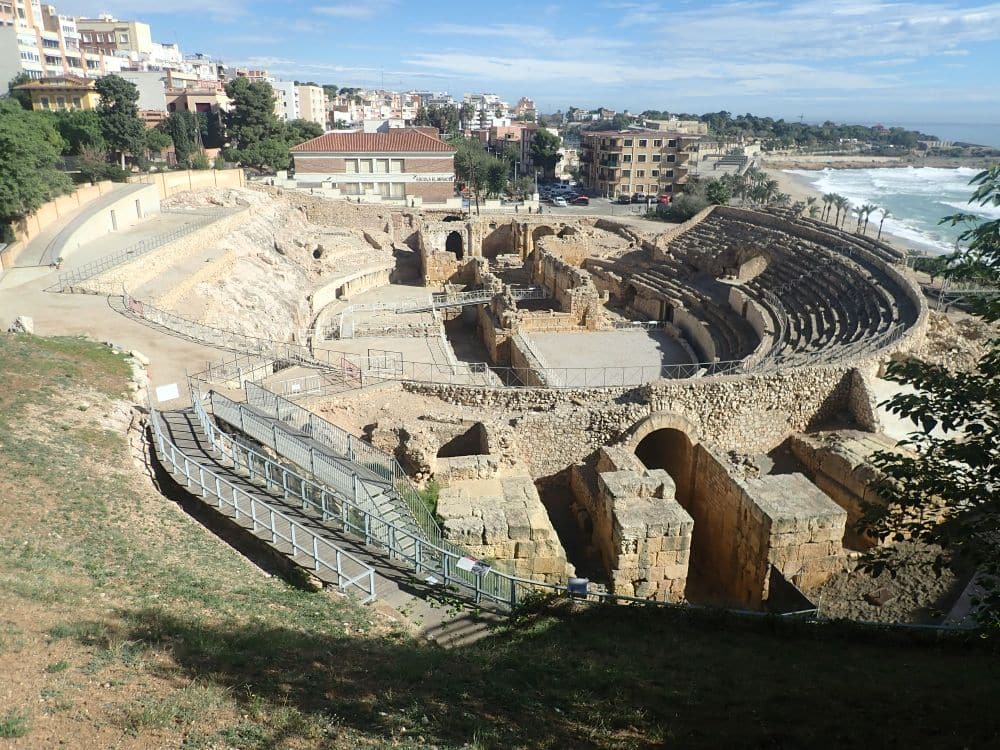
The amphitheatre is at the bottom of the landscaped and terraced Parc del Miracle.
The Circus
The Circus is a long oblong arena with rounded ends that formed a track for chariot races: the most popular spectacle in Roman times. It dates from the end of the first century AD during the reign of Domitian. It stood on strong cement vaults that supported the racetrack and bleachers and served as interior corridors to distribute the visitors like in a modern-day arena.
During the 5th century, a lot of the circus was lost to medieval Tarragona, but the vaults form the foundations of Tarragona Part Alt. Parts of the Circus can be seen in Plaça dels Sedassos. Today much of the footprint of the circus is occupied by the main Tarragona city square of Plaça del Font.
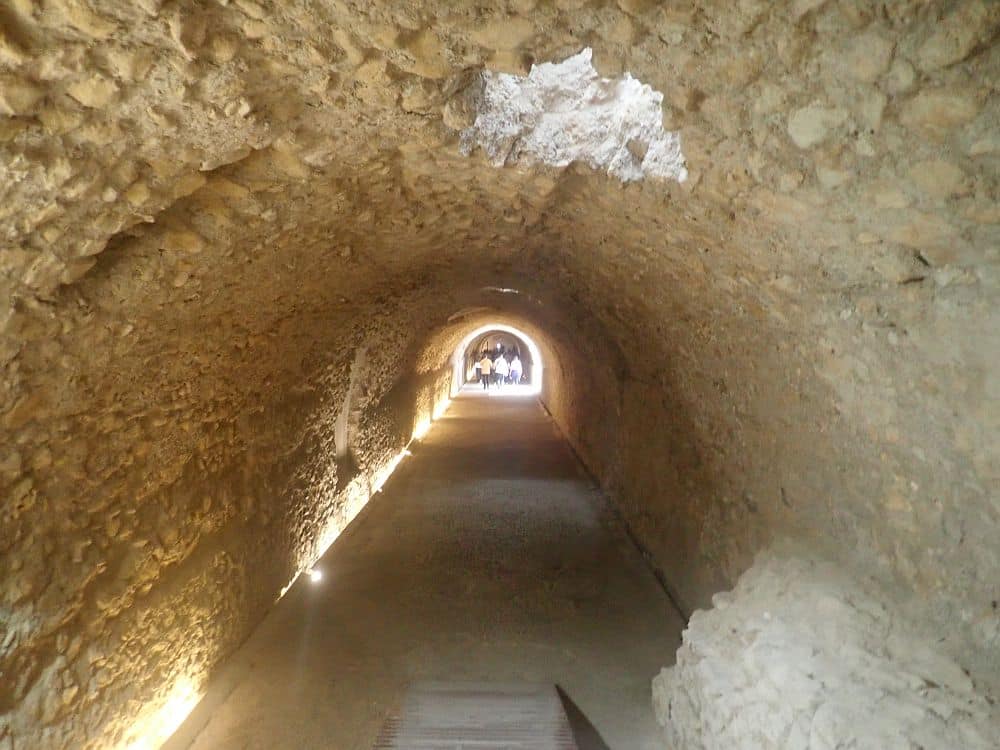
Provincial Forum
Built in 73AD during the reign of Emperor Vespasian, the Provincial Forum stood in the upper terrace of Part Alt to serve as a centre for running the Iberian province. It was divided into two terraces. On the upper terrace was the imperial place of worship (see Plaça del Forum below) and on the lower terrace, the main government building, of which one tower staircase is all that remains.The Circus occupied the third terrace.
The Provincial Forum was structurally unsound at the beginning of the 5th century. The one remaining tower was transformed into a castle for feudal rule after the decline of the Roman Empire.
Within the Provincial Forum stand Roman-era statues. Notable is the Capitoline Wolf sculpture, which depicts Romulus and Remus nursing from a wolf. You will also find a model of the walled city of Tarraco to get an idea of the scale of the Roman city.
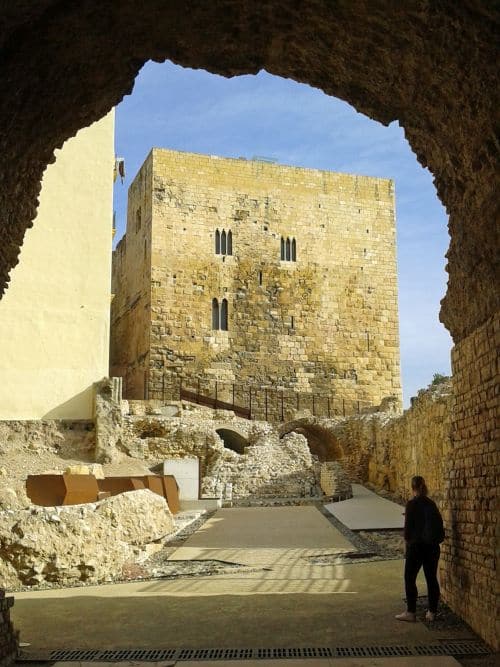
Plaça del Forum
Between the Provincial Forum and the cathedral is a square called Plaça del Forum which contains some Roman perimeter wall ruins.
The Imperial Cult Enclosure (Santa Tecla Cathedral)
At 7.5 hectares (18.5 acres), this complex was the largest of its kind in the Roman world. A portico surrounded the upper square of the Provincial Forum. Large portions of the portico can still be seen in the cloister of the Santa Tecla Cathedral. The cathedral stands on top of the ruins of the Roman temple. In the basement of the cloisters of the cathedral there is a secret room where you can see a Roman hall. Within the cathedral is also a museum in a stone chamber that is Roman in origin.
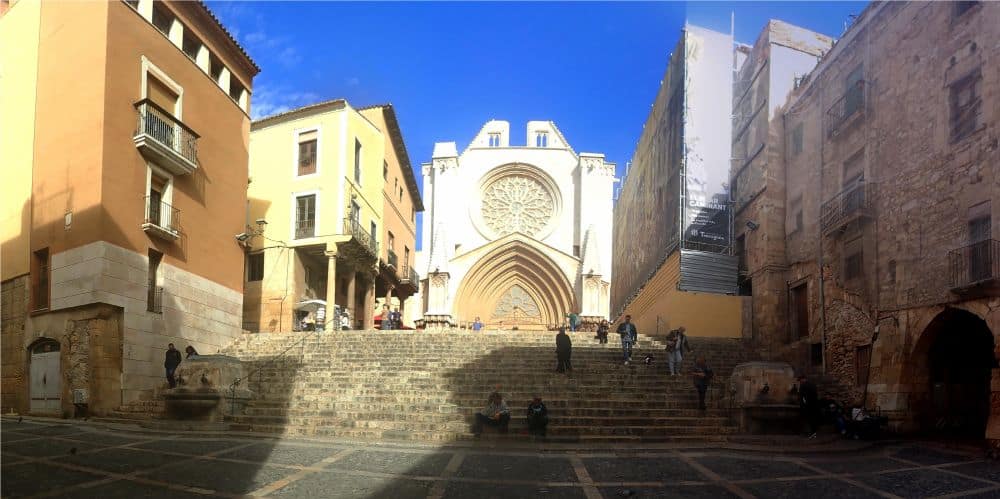
Passeig Arqueològic Roman Wall
A 3.5km (2mi) walk follows the Roman fortification wall, which dates to the establishment of the city in the 3rd century BC. The wall was reinforced in the 16th and 18th centuries with an outer countermure and small forts. As you walk along this route you have the Roman wall on the left and the later wall on the right. The Roman wall is 6m (20ft) tall and 4.5m (15ft) wide with multiple watchtowers.
Within the Passeig Arqueològic Roman Wall is a small museum space (Centre d’Interpretació de les Fortificacions de Tarragona) with displays about the history of the wall and towers.
The Roman ruins of Lower Part & Port Serallo
Roman Theatre
This was a large multi-tiered theatre with a semicircular auditorium facing a stage. It is only open on Sundays at 12:30h for guided tours in Catalan and Spanish. Little remains of the theatre today but if you walk past it there are viewing platforms with informational signs.
Colonial Forum
The Colonial Forum (Forum Adiectum) was a smaller forum that served as the religious, social, political and administrative centre solely for the city of Tarraco, unlike the larger Provincial Forum that dealt with the whole Iberian province. It contained a temple dedicated to Jupiter, Juno and Minerva. The forum probably dates to about 30BC in the Tiberian Era.
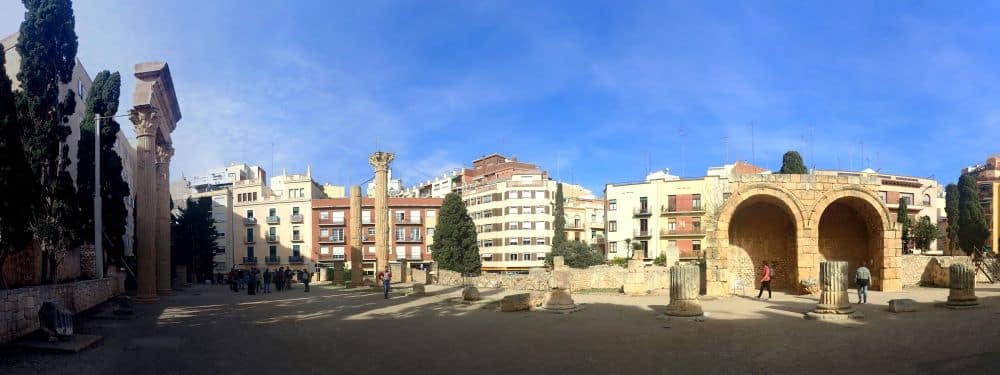
Paleo-Christian Cemetery
Outside of the city of Tarraco is a Paleo-Christian cemetery. In the early 3rd century, south on the Via Augusta, there was a densely-populated suburb that stretched between the walled town, the port and the river Tulcis (today called the river Francolí). There were warehouses and other port facilities as well as some suburban houses and craft workshops.
The Necropolis site was discovered in this area in 1923, when a tobacco factory wanted to expand and initial foundation works revealed a large ancient burial site with more than 2000 documented burials. The archaeological excavations were done with assistance from the workers of the tobacco factory. Only in Spain could a tobacco factory be involved in the excavation and preservation of a historic cemetery!
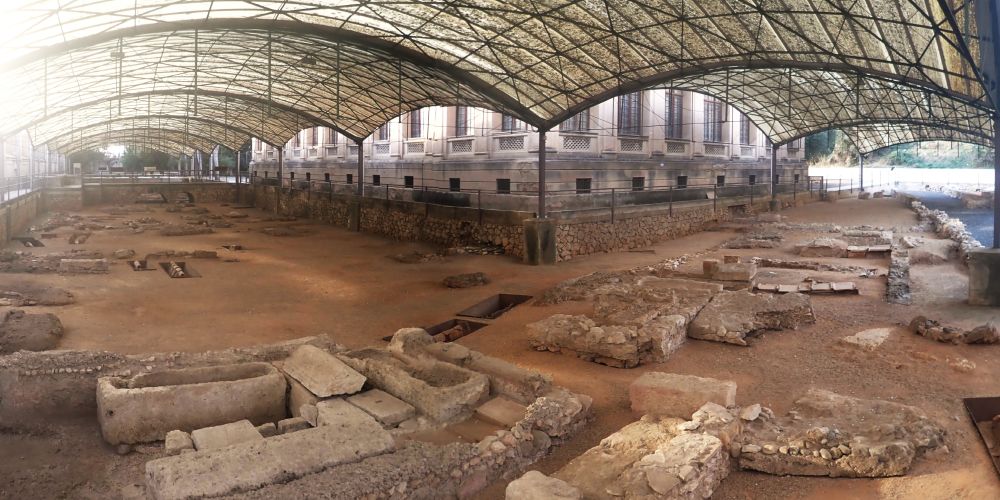
This Necropolis was used as a burial site up until the 7th century for both pagan and Christian internment. The site contains sarcophagi, amphora, tombs and burial ornaments as well as headstones.
On both sides of Via Augusta and other main roads in the area there was a large number of tombs. Sometimes the remains of the deceased were interred with just a small mound while others had grand mausoleums and funerary monuments built by their families to demonstrate their importance.
The building at the centre of the site is El Museo Monograficó. Within the site’s entrance is a small museum space as well as the large exterior exhibition.
Like at all good cemeteries, a colony of friendly (and indifferent) cats watches over the graves.
Tinglado 4 building in Port Serallo
Although not listed as part of the World Heritage site, I have included this location because it is the main museum space for Roman artifacts recovered from the various sites in and around Tarraco. The current building is a temporary exhibition space during the refurbishment of the MNAT building in Plaça del Rei.
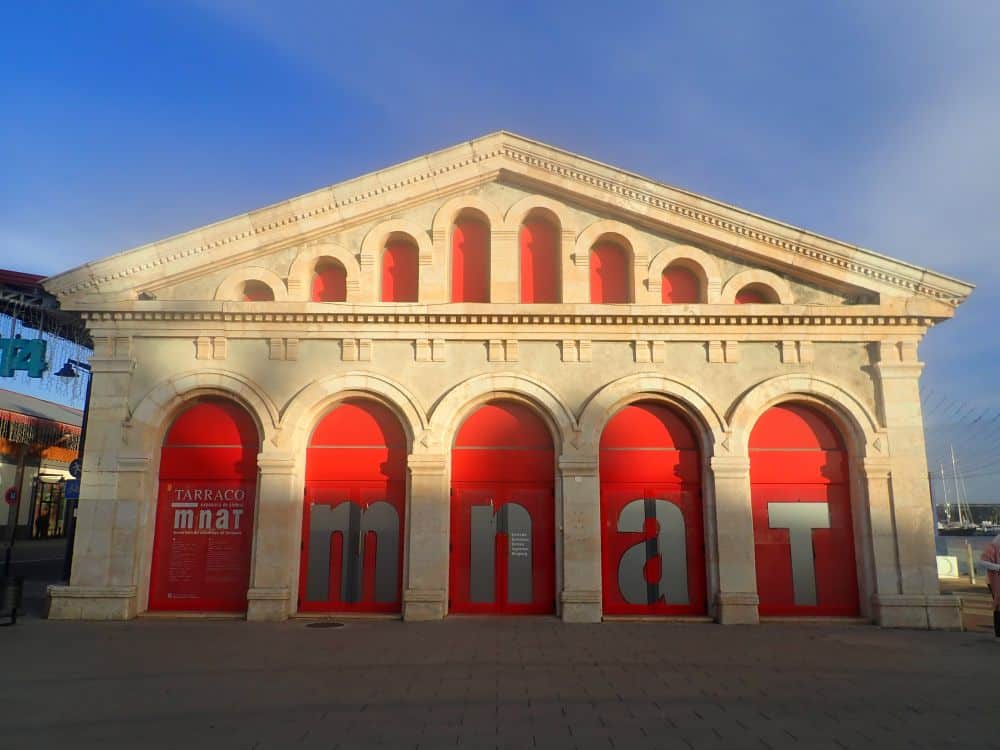
Within this building is a large collection of statues, pottery, jewellery, mosaics, children’s toys and puppets, marble fountain segments recovered from the temple, and many more diverse items from Roman life.
Roman ruins outside of Tarragona City centre
Les Ferreres Roman Aqueduct
Tarraco aqueduct, known as Acueducto de Ferreres or Puente del Diable is a 249-metre-long (817ft) structure that crosses the Barranc del Diable river valley with a maximum height of 27m (89ft). It is located 3km (2mi) outside of Tarragona city in Parque Ecohistórico del Puente del Diable.
The aqueduct is a small fragment of a much larger 10km-long canal network that supplied Tarraco with water sourced from the hills in the Rourell area. It’s not as high as the more famous Pont du Gard in France, but it’s equally impressive.
The aqueduct consists of 25 arches sitting on a lower tier of 11 arches. Dating to the 1st century AD, it was built from large square-cut stones stacked without mortar to form the two tiers of arches. The floor of the canal bed was lined with a mortar called opus signinum to waterproof it. On top, the canal was covered with large capstones to seal in the water. The water from the aqueduct was distributed into large holding tanks in Tarraco before being piped to the buildings.
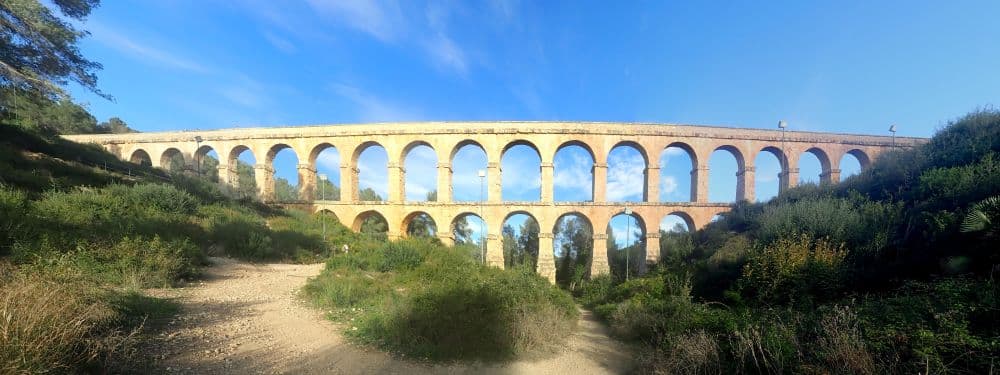
The viaduct has been preserved and the canal is a walkable path all the way along the top of the aqueduct, with fantastic views from 27m (89ft) up in the air. The capstone covers are gone.
Tower of Scipios
Romans often buried their dead near roads on the outskirts of the city. This 1st-century funeral monument is located next to what is now the N-340 highway about 7km (4mi) outside of Tarragona. It is a tomb monument shaped like an obelisk, but the top part and the pyramid point have been lost to time. The central tower includes a depiction of two figures representing the funeral god, Attis. Its location on a busy highway and not near public transport make this monument not worth a visit when compared with the other monuments.
Roman quarry of El Mèdol
El Mèdol Roman quarry is located about 6km (4mi) outside of Tarraco, near the town of Tamarit-Altafulla. It provided building stone for the city. Its most interesting feature is at the centre of the excavation, where the Romans left a column of intact original rock (like an obelisk) frequently found in Roman quarries.
If Roman ruins are of particular interest to you, there are many more Roman UNESCO sites. Here are just a few of them:
- In Spain: Besides Tarragona, see Segovia and Mérida.
- In Italy: Pompeii, Herculaneum and Torre Annunziata, Villa Adriana and Villa Romana del Casale
- In Germany: Roman Monuments in Trier
- In France: Pont du Gard (Aqueduct)
- In Lebanon: Baalbek and Byblos
The Centcelles Villa-mausoleum
This farmstead from the 5th century AD contains a tomb complex with preserved mosaics inside. Its location, 6km (4mi) from Tarragona city centre, makes it difficult to access without a car. It is a short walk from the village of Constantí, which is served by bus.
Triumphal Arch of Berá
The Triumphal Arch of Berá is 20km (12mi) north of Tarragona and consists of an arch that crossed the Roman highway, Via Augusta, now the N-340 highway. It is not easily accessible via public transport and not worth the effort of a long walk. If you visit by car you will have to cross a busy highway, which could be dangerous.
Vila dels Munts
Located on the edge of the town of Altafulla (14km (9mi) or one train stop from Tarragona) is the Roman Vila del Munts, dating from the 2nd century BC. This was a small farming community that harvested grapes, wheat and other crops. Within the community was a Roman bath complex and a large house with basement storage for farm produce.
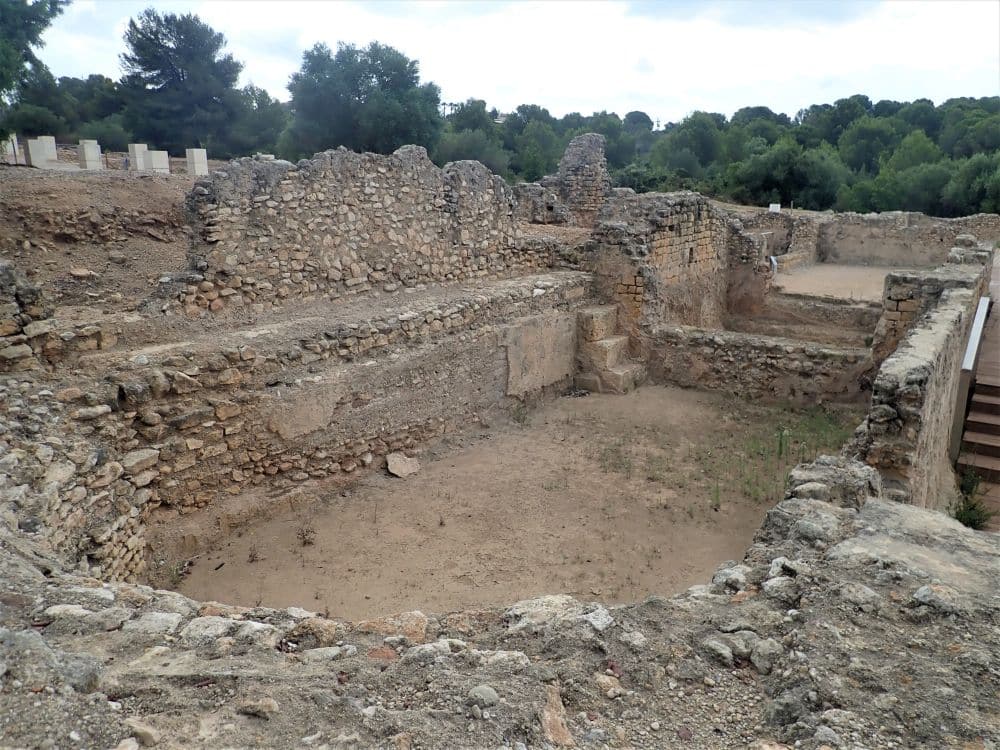
The site also contained grain storage, barns, stables, wineries, ovens and smithies, with housing for slave and servant workers who performed the field work. At the top of the site are two large water cisterns. The remains of the grand house include a large mosaic floor.
Vila de Munts sits on a hill overlooking the town of Altafulla and contains a small museum of artifacts recovered from the site.
Use this link to compare rental car prices.
Is the Archaeological Ensemble of Tarraco worth a visit?
Tarraco is definitely worth visiting for a stroll around the grand old buildings of Part Alt, visualising Roman and medieval citizens moving around the city. Walking around the city is completely free and contains many architecturally highlights as well as traditional cobbled streets.
Tarragona is 70 minutes from Barcelona by train, which makes it an easy day trip for people who love old cities with character. It’s even easier if you take a private tour with pick-up from your hotel in Barcelona.
Book a hotel in Barcelona here.
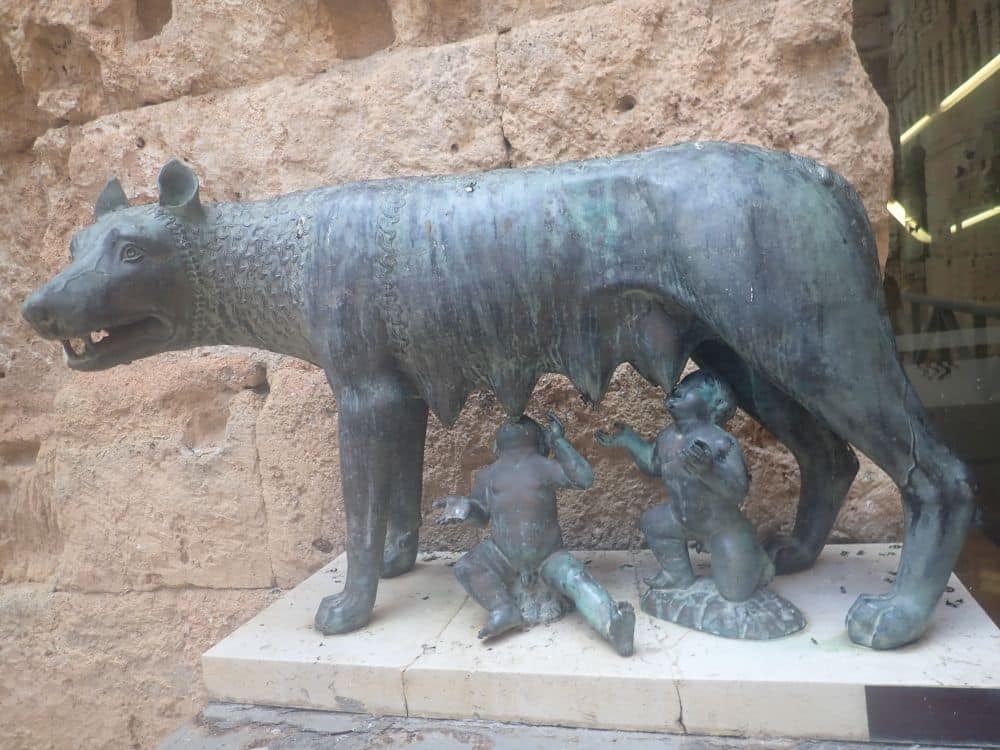
When you walk around Part Alt in the narrow medieval streets, you can see that all the buildings are stone. Medieval Tarragona was built on top of the Roman town, reusing stone from the Roman period or adding an additional floor to an existing Roman building. This part of the town has an abundance of old-world charm.
Tarragona is a vibrant city that hosts many cultural and sporting events all year round and you may find festivals going on in the streets.
What sorts of travellers would like the Archaeological Ensemble of Tarraco?
If you like walking around old cities in the open air and visiting grand monuments then this is ideal for you. Anyone interested in Roman and/or medieval history would like it too.
Tips for visiting the Archaeological Ensemble of Tarraco
Because of the location of Tarragona on the coast south of Barcelona, the climate is mild and makes the city visitable any time of the year, though it gets very hot in the summertime.
The entire ensemble of Roman ruins and medieval stately homes in Tarragona takes three to four days to visit. I actually spent four days visiting everything inside Tarragona city plus additional days for the attractions outside of the city.
Use the map below to book your accommodations in Tarragona:
It might be tempting to skip the Roman Aqueduct because it is outside of the city centre and requires a bus or car to get to, but the state of preservation and the park it sits in make it one of the best Roman- era attractions in Tarragona. The size of the aqueduct will give you the wow factor when you see it side on and when you walk along the top of it.
I would skip the Tower of Scipios, Triumphal Arch of Berá and Centcelles Villa-mausoleum because they are minor curiosities outside of Tarragona city. When compared with the other monuments in this ensemble, they are lower value and more time-consuming.
The Part Alt is all cobbled streets so wear comfortable shoes so that you don’t destroy your ankles.
Roman museums are further apart in the lower part of Tarragona so some walking is required between attractions.
The Roman ruins are managed by two bodies:
It might be tempting to buy an individual ticket for each attraction but the combined MHT ticket includes the museums listed below. The ticket has no expiry date. As you visit each attraction it gets punched to mark it off so you can only visit each of these museums once with a combined ticket.
- Roman Amphitheatre – Parc de l’amfiteatre, s/n, 43003 Tarragona
- Roman Circus – Rambla Vella, 2, 43003 Tarragona
- Roman Provincial Forum– Pl. del Rei, s/n, 43003 Tarragona
- Roman Colonial Forum – Carrer de Lleida, s/n, 43001 Tarragona
- Roman wall Passeig Arqueològic – Rambla Vella, 1, 43003 Tarragona
- Roman Aqueduct (free entry, no ticket required) – Parc Ecohistoric Pont del Diable, 43001 Tarragona
- Casa Canals (medieval stately home built into Roman city walls) – C/ d’En Granada, 11, 43003 Tarragona
- Casa Castellarnau (medieval stately home built into Roman city walls) – Carrer dels Cavallers, 14, 43003 Tarragona
Note that to visit the two medieval stately homes and the free modern art museum, (Carrer de Santa Anna, 8, 43003 Tarragona), I recommend Tarragona as a three day itinerary, which you can find here.
When you buy a ticket for one of the below MNAT museums it is also valid in the other museum:
- Paleo-Christian Cemetery – Av. de Ramón y Cajal, 84, 43005 Tarragona
- National Archaeological Museum of Tarragona in the Tinglado 4 building – Tinglado, 4, 43004 Tarragona
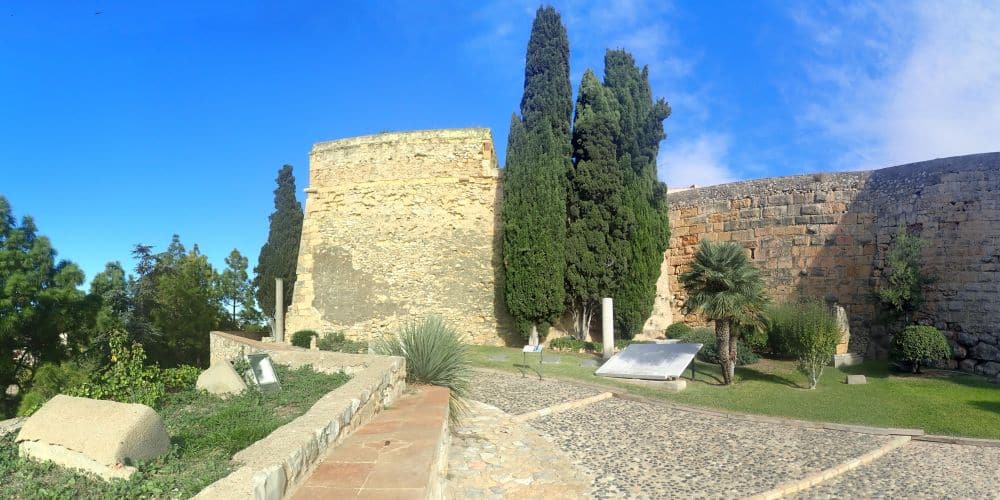
Tarragona Cathedral is not part of MHT or MNAT so you’ll need to buy a separate ticket, which costs €11. This might seem a bit pricy to visit a cathedral but the cultural visit ticket includes the cathedral, museum, cloisters and roman ruins in the basement of the cloister and is good value for money. I spent about 90 minutes in the cathedral – Pla de la Seu, 1, 43003 Tarragona
You can buy MHT and MNAT tickets at any of their museum attractions on the day or online.
I visited the Vila dels Munts Roman ruins as part of a day 18km coastal hike by train starting from Torredembarra and finishing in Tarragona. I also hiked this section of coastline on a shorter 14km route starting at Altafulla-Tamart and finishing in Tarragona. These routes are great in the summer for visiting wild beaches like the famous Waikiki beach. Along the routes you will find small pits cut into the rock of the shore. These may be from Roman and early medieval periods and were used to store live fish, wash clothes, fishing nets etc, and personal bathing.
An alternative would be to visit Altafulla-Tamarit as a beach day trip with cultural visits in the morning. You can visit Villa dels Munts, then walk (or taxi) to El Médol Roman Mine. The mine is free entry. Or take a two-hour guided Roman Heritage tour.
Where is the Archaeological Ensemble of Tarraco?
The various sites are in or outside the modern city of Tarragona.
By Train from Barcelona: Renfe REGIONAL R14, R15, R16 & R17 lines all go to Tarragona city centre from Barcelona-Estació de França, Barcelona-Passeig de Gràcia and Barcelona-Sants. Journey time is 70 minutes.
By car from Barcelona: Take the C32 motorway leaving Barcelona and follow it as it transitions into the AP7 motorway. Take exit 33 toward Tarragona. Aparcament Municipal Saavedra pay parking is near the Roman City Walls. Allow about 70 minutes’ driving time from Barcelona to Tarragona.
By Bus from Barcelona: Use the Alsabus service from Barcelona Estacio del Nord to Tarragona Estació d’Autobusos.
My recommended method is to take a regional train to Tarragona. Note that the high-speed (avolo, AVE, Omnio, etc.) service does not stop at Tarragona station but at Camps de Tarragona. This is the new high-speed station that stands some 20km from Tarragona city in the middle of farmland. It has infrequent bus service linking it to the city. Camps de Tarragona has a 30-min journey time from Barcelona but is useless for visiting the city. Ensure that you get a train ticket to Tarragona (not Camps de Tarragona) via a regional service (R14, R15, R16 & R17) that takes about 70 minutes.
Caution: Some online ticket sale platforms do not differentiate between Tarragona and Camps de Tarragona, but the journey time is the dead giveaway on these platforms.
The train is the best method of travel for enjoying the Mediterranean food and wine! Plus, on the way back you get to see the sun set over the Mediterranean Sea as the train route runs along the coast.
For more information about The Roman Archaeological Ensemble of Tarraco, its opening hours and admission fees, see the MHT and MNAT websites.
Have you been to Tarragona? If so, do you have any additional information or advice about this UNESCO World Heritage site? Please add your comments below!

